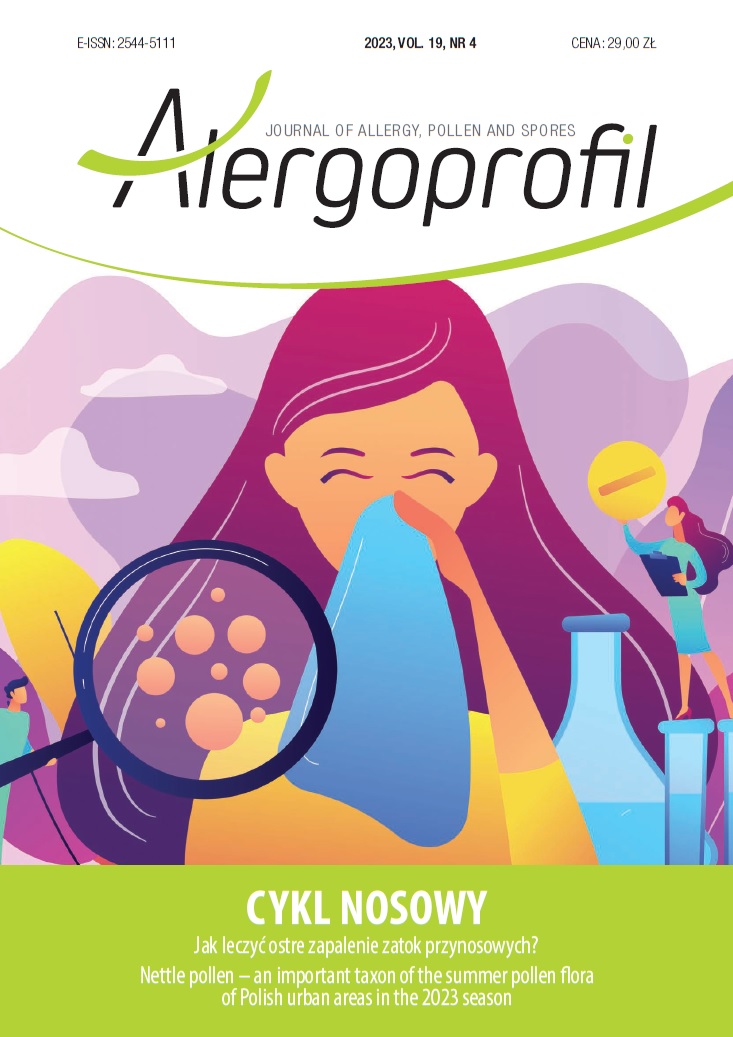Cykl nosowy Artykuł przeglądowy
##plugins.themes.bootstrap3.article.main##
Abstrakt
Cykl nosowy jest zjawiskiem fizjologicznym, które może powodować okresową zmianę drożności jam nosa poprzez zmiany w przekrwieniu i obkurczeniu błony śluzowej nosa, a zwłaszcza małżowin nosowych dolnych. Po raz pierwszy zjawisko to zostało opisane przez niemieckiego lekarza Richarda Kaysera w 1895 r. Cykl nosowy jest regulowany przez podwzgórze za pomocą współczulnego układu nerwowego. Na przepływ powietrza przez jamy nosa wpływają takie czynniki, jak: hiperwentylacja, zmiana pozycji ciała, temperatura powietrza, stany chorobowe nosa, infekcja, alergia i naczynioruchowy nieżyt nosa, a także leki takie jak kwas acetylosalicylowy i sympatykomimetyki.
Pobrania
##plugins.themes.bootstrap3.article.details##

Utwór dostępny jest na licencji Creative Commons Uznanie autorstwa – Użycie niekomercyjne – Bez utworów zależnych 4.0 Międzynarodowe.
Copyright: © Medical Education sp. z o.o. This is an Open Access article distributed under the terms of the Attribution-NonCommercial 4.0 International (CC BY-NC 4.0). License (https://creativecommons.org/licenses/by-nc/4.0/), allowing third parties to copy and redistribute the material in any medium or format and to remix, transform, and build upon the material, provided the original work is properly cited and states its license.
Address reprint requests to: Medical Education, Marcin Kuźma (marcin.kuzma@mededu.pl)
Bibliografia
2. Kahana-Zweig R, Geva-Sagiv M, Weissbrod A et al. Measuring and Characterizing the Human Nasal Cycle. PLoS One. 2016; 11(10): e0162918. http://doi.org/10.1371/journal.pone.0162918.
3. Kumaran EM. Alteration in Nasal Cycle Rhythm as an Index of the Diseased Condition. In: Pathophysiology – Altered Physiological States. InTech; 2018. http://doi.org/10.5772/intechopen.70599.
4. Asakura K, Hoki K, Kataura A et al. Spontaneous Nasal Oscillations in Dog: A Mucosal Expression of the Respiration- related Activities of Cervical Sympathetic Nerve. Acta Otolaryngol. 1987; 104(5-6): 533-38. http://doi.org/10.3109/00016488709128285.
5. Ishii J, Ishii T, Ito M. The Nasal Cycle in Patients with Autonomic Nervous Disturbance. Acta Otolaryngol. 1993; 113(suppl. 506): 51-6. http://doi.org/10.3109/00016489309130241.
6. Mainland J, Sobel N. The Sniff Is Part of the Olfactory Percept. Chem Senses. 2006; 31(2): 181-96. http://doi.org/10.1093/chemse/bjj012.
7. Scott JW, Sherrill L, Jiang J et al. Tuning to Odor Solubility and Sorption Pattern in Olfactory Epithelial Responses. J Neurosci. 2014; 34(6): 2025-36. http://doi.org/10.1523/JNEUROSCI.3736-13.2014.
8. Williams MR, Eccles R. The nasal cycle and age. Acta Otolaryngol. 2015; 135(8): 831-4. http://doi.org/10.3109/00016489.2015.1028592.
9. Raghuraj P, Telles S. Immediate Effect of Specific Nostril Manipulating Yoga Breathing Practices on Autonomic and Respiratory Variables. Appl Psychophysiol Biofeedback. 2008; 33(2): 65-75. http://doi.org/10.1007/s10484-008-9055-0.
10.Kotan D, Tatar A, Aygul R et al. Assessment of nasal parameters in determination of olfactory dysfunction in Parkinson’s disease. J Int Med Res. 2013; 41(2): 334-9. http://doi.org/10.1177/0300060513476433.
11. White DE, Bartley J, Nates RJ. Model demonstrates functional purpose of the nasal cycle. Biomed Eng Online. 2015; 14(1): 38. http://doi.org/10.1186/s12938-015-0034-4.
12. Soane RJ, Carney AS, Jones NS et al. The effect of the nasal cycle on mucociliary clearance. Clin Otolaryngol Allied Sci. 2001; 26(1): 9-15. http://doi.org/10.1046/j.1365-2273.2001.00423.x.
13. Eccles RB. The nasal cycle in respiratory defence. Acta Otorhinolaryngol Belg. 2000; 54(3): 281-6.
14. Tatar A, Altas E. Nasal Cycle Pattern Can Transform Into Another Form Over Time. Electron J Gen Med. 2014; 11(1): 1-5. http://doi.org/10.15197/sabad.1.11.01.
15. Pendolino AL, Scarpa B, Ottaviano G. Relationship Between Nasal Cycle, Nasal Symptoms and Nasal Cytology. Am J Rhinol Allergy. 2019; 33(6): 644-9. http://doi.org/10.1177/1945892419858582.
16. Gotlib T, Samoliński B, Grzanka A. Effect of the nasal cycle on congestive response during bilateral nasal allergen provocation. Ann Agric Environ Med. 2014; 21(2): 290-3. http://doi.org/10.5604/1232-1966.1108593.

